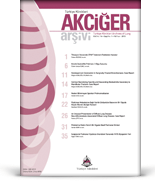Amaç: Kot kırıklarında hastaneye ve yoğun bakıma yatış ihtiyacı ve komplikasyonlarda artışa neden olan risk faktörleri konusunda tartışmalar vardır. Bu çalışmanın amacı, hasta yatışından sonraki ilk günlerde plöroparankimal komplikasyonların ortaya çıkışını öngörebilecek faktörleri analiz etmek ve kaburga kırıklarının sayısının bu komplikasyonların ortaya çıkmasıyla ilişkili olup olmadığını belirlemeye çalışmaktır. Gereç ve Yöntemler: 2015 Ocak ile 2020 Aralık ayı arasında künt travma sonrası kliniğimize başvuran ve toraks bilgisayarlı tomografi ile multipl kot kırıkları tanısı alan 155 hasta çalışmaya dâhil edildi. Hastaların yaş, cinsiyet, travma nedeni, eşlik eden kronik obstrüktif akciğer hastalığı (KOAH), sigara kullanımı, fraktür sayısı, hastane yatış süresi, yatıştan 24 saat sonra ortaya çıkan plöroparankimal komplikasyonlar ve tüp torakostomi ihtiyacı arşiv dosyaları ve otomasyon sisteminde kayıtlı bilgilerden elde edildi. Yatıştan 24 saat ve sonrasında plöroparankimal komplikasyon gelişen hastalar Grup 1, komplikasyon gelişmeyen hastalar ise Grup 2 olarak kabul edildi. Bulgular: Çalışmaya dâhil edilen hastaların 104'ü erkek iken, 51'i kadın idi. Yaş ortalaması 64,5±13,3 idi. Yapılan istatistiksel çalışmada hastanın yatışından 24 saat ve sonrasında plöroparankimal komplikasyon çıkmasını etkileyen risk faktörleri saptanmaya çalışıldı. Plöroparankimal komplikasyonlar ile KOAH varlığı (p=0,030), immobilizasyon (p=0,020), 3-4 kot (p=0,030) veya 5-6 kot fraktürü (p=0,000) ve bilateral kot fraktürü (p=0,150) arasında anlamlı istatistiksel ilişki vardı. Plöroparankimal komplikasyonlar ile yaş (p=0,980), cinsiyet (p=0,240), sigara (p=0,090), travma nedeni (p=0,890) ve 1-2 adet kot fraktürü (p=0,150) arasında istatistiksel olarak anlamlı ilişki yoktu. Sonuç: 3 ve 3'ten fazla kot kırıkları veya bilateral kot kırıkları olan hastalar, KOAH varlığı, diğer travmalar nedeniyle immobil olan hastalarda geç dönem plöroparankimal komplikasyonların ortaya çıkma riskinin yüksekliği nedeniyle hastaların hospitalize edilerek takip edilmeleri uygun olacaktır.
Anahtar Kelimeler: Kot kırığı; plöroparankimal komplikasyon; risk faktörleri
Objective: There are debates about the need for hospitalization and intensive care unit admission and the risk factors that cause an increase in complications in rib fractures. The aim of this study is to analyze the factors that may predict the occurrence of pleuroparenchymal complications in the first days after hospitalization and to try to determine whether the number of rib fractures is associated with the occurrence of these complications. Material and Methods: One hundred fifty-five patients who applied to our clinic after blunt trauma between January 2015 and December 2020 and were diagnosed with multiple rib fractures by thoracic computed tomography were included in the study. The patients' age, gender, cause of trauma, concomitant chronic obstructive pulmonary disease (COPD), smoking, number of fractures, length of hospital stay, pleuroparenchymal complications occurring 24 hours after hospitalization, and the need for tube thoracostomy were obtained from the archive files and the information recorded in the automation system. Patients who developed pleuroparenchymal complications 24 hours after hospitalization were considered as Group 1, and patients without complications were considered Group 2. Results: While 104 of the patients included in the study were male, 51 were female. The mean age was 64.5±13.3 years. In the statistical study, it was tried to determine the risk factors affecting the occurrence of pleuroparenchymal complications 24 hours and after the hospitalization of the patient. There was statistically significant cerrelation between pleuroparenchymal complications and presence of COPD (p=0.030), immobilization (p=0.020), 3-4 rib (p=0.030) or 5-6 rib fracture (p=0.000) and bilateral rib fracture (p=0.150). There was no statistically significant correlation between pleuroparenchymal complications and age (p=0.980), gender (p=0.240), smoking (p=0.090), cause of trauma (p=0.890), and 1-2 rib fractures (p=0.150). Conclusion: Patients with 3 and more than 3 rib fractures or bilateral rib fractures, the presence of COPD, and patients who are immobile due to other traumas should be hospitalized and followed-up due to the high risk of delayed pleuroparenchymal complications.
Keywords: Rib fracture; pleuroparenchymal complication; risk factors
- Flagel BT, Luchette FA, Reed RL, Esposito TJ, Davis KA, Santaniello JM, et al. Half-a-dozen ribs: the breakpoint for mortality. Surgery. 2005;138(4):717-23; discussion 723-5. [Crossref] [PubMed]
- Sirmali M, Türüt H, Topçu S, Gülhan E, Yazici U, Kaya S, et al. A comprehensive analysis of traumatic rib fractures: morbidity, mortality and management. Eur J Cardiothorac Surg. 2003;24(1):133-8. [Crossref] [PubMed]
- Todd SR, McNally MM, Holcomb JB, Kozar RA, Kao LS, Gonzalez EA, et al. A multidisciplinary clinical pathway decreases rib fracture-associated infectious morbidity and mortality in high-risk trauma patients. Am J Surg. 2006;192(6):806-11. [Crossref] [PubMed]
- Easter A. Management of patients with multiple rib fractures. Am J Crit Care. 2001;10(5):320-7; quiz 328-9. [Crossref] [PubMed]
- Émond M, Sirois MJ, Guimont C, Chauny JM, Daoust R, Bergeron É, et al. Functional impact of a minor thoracic injury: an investigation of age, delayed hemothorax, and rib fracture effects. Ann Surg. 2015;262(6):1115-22. [Crossref] [PubMed]
- Whitson BA, McGonigal MD, Anderson CP, Dries DJ. Increasing numbers of rib fractures do not worsen outcome: an analysis of the national trauma data bank. Am Surg. 2013;79(2):140-50. [Crossref] [PubMed]
- Flores-Funes D, Lluna-Llorens AD, Jiménez-Ballester MÁ, Valero-Navarro G, Carrillo-Alcaráz A, Campillo-Soto Á, et al. Is the number of rib fractures a risk factor for delayed complications? A case-control study. Eur J Trauma Emerg Surg. 2020;46(2):435-40. [Crossref] [PubMed]
- Gonzalez KW, Ghneim MH, Kang F, Jupiter DC, Davis ML, Regner JL. A pilot single-institution predictive model to guide rib fracture management in elderly patients. J Trauma Acute Care Surg. 2015;78(5):970-5. [Crossref] [PubMed]
- Butts CC, Miller P, Nunn A, Nelson A, Rosenberg M, Yanmis O, et al. RIB fracture triage pathway decreases ICU utilization, pulmonary complications and hospital length of stay. Injury. 2021;52(2):231-4. [Crossref] [PubMed]
- Battle CE, Hutchings H, Evans PA. Risk factors that predict mortality in patients with blunt chest wall trauma: a systematic review and meta-analysis. Injury. 2012;43(1):8-17. [Crossref] [PubMed]
- Bulger EM, Arneson MA, Mock CN, Jurkovich GJ. Rib fractures in the elderly. J Trauma. 2000;48(6):1040-6; discussion 1046-7. [Crossref] [PubMed]







.: İşlem Listesi